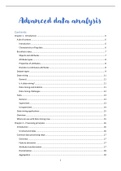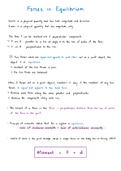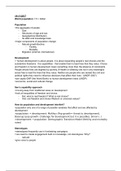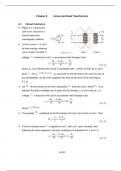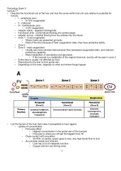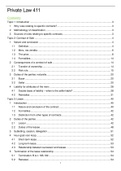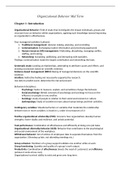Behavioral Decision Making
2021-2022
Lecture 1 - Introduction
Through the eyes of a classic economic rational decision making is based on three
fundamentals:
1 – People are rational and aim to maximize their utility: People take specific steps to make
decisions to maximize the benefit. Two options are being compared (in our head) and then
will be calculated/reviewed by the one which option benefits the most.
2 – People are driven by monetary incentive: Any effort people show is a reflection of the
money they receive à more money = work harder.
3 – optimal decisions are made at the margin: Any rational individual will continue the task if
it out way’s the cost. The moment the costs are bigger than the benefit the person
discontinuous the activity/task.
Expected Utility Theory
The expected utility theory is the normative theory of behaving à class of theory’s which is
supposed to show and predict human behavior.
§ Rational decisions maker can maximize their utility by selecting among superior
alternatives.
§ When alternatives have similar outcomes, decision maker should be indifferent to
these alternatives.
§ Utility is dependent of final wealth.
Economists adopted the Expected Utility Model as (1) a logic that defines how decision
should be made and a theory of how people do make decisions, and (2) a description of how
probably Economists make choices.
Example:
Which gamble do you prefer?
- A. 60% chance of winning €100 and 40% chance of €0
- B. 100% chance of winning €50 and 0% chance of €0
People maximize utility (expected value)
Probability * Value
- A. 0.6 * €100 + 0.4 * €0 = €60
- B. 1.0 * €50 + 0 * €0 = €50
According to the EUT people should choose option A, but the study/experiment showed
otherwise: people B instead of A à Risk aversion.
Page | 1
,Psychologists noticed that the Expected Utility Model makes faulty predictions about human
decision making that does not reflect how decisions are made in real life à they started to try
and understand how humans ‘actually’ made decisions.
Expected Real-life choice
Utility theory Situation
è The Prospect Theory is a theory of behavioral that experimental establishes how humans
behave, that’s why it’s known as a descriptive instead of a normative theory. This theory
disagrees with everything the normative theory states. It believes people are terrible at
making decisions and this theory shows people really listen to their emotions when making
decisions. There are four fundamental patterns that the Prospect Theory has observed:
1. People are loss aversive (losses loom larger than gains): pain of a loss is felt deeper
than the joy of a gain. People like gains but hate losses even more.
2. People’s risk propensity is determined by how options are framed: the extent to which
people are willing to take or avoid taking risks is highly defined by how questions and
options are framed or asked.
3. People evaluate the consequences in terms of deviation from a reference point
(Individuals Status Quo): how much am I gaining from this decision and how much can
I lose.
4. People experience diminished sensitivity to losses and gains: at a certain point people
get used to a certain gain, so it’s less meaningful. For example: from €100 to €200
feels more impactful than €900 to €1000 à this is called indifferent to gains or losses:
can’t get any worse at rock bottom.
Hypothetical graph could look like this
Altough the Prospect theory started off with outlining decision making und er conditions of
risks and uncertainty. The implication of the theory was so far reaching that it formed the
groundwork required to explain other unexplainable human behavior.
Page | 2
, Prospect Theory (framing choices and losses version)
Gain frame (risk aversion) à people are asked to choose a gain.
Which gamble do you choose?
A – Get €900 for sure
B – 90% chance to get €1000.
Hereby people avoid the risk and go with the save/assure option to get the €900 for sure à
so a lot of risk aversion. People fear being disappointed if their luck does not hold, and they
land in that 10% chance that would get nothing. This leads to people taking the sure gamble.
Loss frame (risk seeking) à people are asked to choose a loss.
Which gamble do you choose?
A – Lose €900 for sure
B – 90% chance to lose €1000
In this option people are risk seeking. People don’t want to lose the €900 for sure and are
therefore a psychological pushed into taking the risk. When people are giving two bad options,
they become more risk seeking à ‘I don’t want to take the sure loss, I’d rather take a chance!’
This shows losses loom bigger than gain: losing €100 vs. finding €100 à intensity of sadness
> intensity of happiness.
Here can be noted that the prospects gain/loss in both questions are the same. The style in
which questions are framed and asked influence the way we make decisions. We do not
engage is any type of calculations, but rather let the emotions or the way a frame makes us
feel guide our decisions. Here the fact that it was a loss or gain frame guided the decisions of
gambling or not.
The utility theory doesn’t take the reference point into account, whereas the prospect theory
does. In the morning person 1 has 10M and person 2 has 1M, but in the afternoon they both
have 5M. According to the utility theory both persons are equally happy because the utility is
dependent of final wealth and 5M is a lot to be happy with, but everyone knows that isn’t
true, because they didn’t use the reference point from person 1 à losing 5M. Any comparison
we make in life we use a reference point. The prospects theory claims/shown that it’s not the
final state what matters, but the upgrade or downgrade from that reference point what
matters.
Page | 3
2021-2022
Lecture 1 - Introduction
Through the eyes of a classic economic rational decision making is based on three
fundamentals:
1 – People are rational and aim to maximize their utility: People take specific steps to make
decisions to maximize the benefit. Two options are being compared (in our head) and then
will be calculated/reviewed by the one which option benefits the most.
2 – People are driven by monetary incentive: Any effort people show is a reflection of the
money they receive à more money = work harder.
3 – optimal decisions are made at the margin: Any rational individual will continue the task if
it out way’s the cost. The moment the costs are bigger than the benefit the person
discontinuous the activity/task.
Expected Utility Theory
The expected utility theory is the normative theory of behaving à class of theory’s which is
supposed to show and predict human behavior.
§ Rational decisions maker can maximize their utility by selecting among superior
alternatives.
§ When alternatives have similar outcomes, decision maker should be indifferent to
these alternatives.
§ Utility is dependent of final wealth.
Economists adopted the Expected Utility Model as (1) a logic that defines how decision
should be made and a theory of how people do make decisions, and (2) a description of how
probably Economists make choices.
Example:
Which gamble do you prefer?
- A. 60% chance of winning €100 and 40% chance of €0
- B. 100% chance of winning €50 and 0% chance of €0
People maximize utility (expected value)
Probability * Value
- A. 0.6 * €100 + 0.4 * €0 = €60
- B. 1.0 * €50 + 0 * €0 = €50
According to the EUT people should choose option A, but the study/experiment showed
otherwise: people B instead of A à Risk aversion.
Page | 1
,Psychologists noticed that the Expected Utility Model makes faulty predictions about human
decision making that does not reflect how decisions are made in real life à they started to try
and understand how humans ‘actually’ made decisions.
Expected Real-life choice
Utility theory Situation
è The Prospect Theory is a theory of behavioral that experimental establishes how humans
behave, that’s why it’s known as a descriptive instead of a normative theory. This theory
disagrees with everything the normative theory states. It believes people are terrible at
making decisions and this theory shows people really listen to their emotions when making
decisions. There are four fundamental patterns that the Prospect Theory has observed:
1. People are loss aversive (losses loom larger than gains): pain of a loss is felt deeper
than the joy of a gain. People like gains but hate losses even more.
2. People’s risk propensity is determined by how options are framed: the extent to which
people are willing to take or avoid taking risks is highly defined by how questions and
options are framed or asked.
3. People evaluate the consequences in terms of deviation from a reference point
(Individuals Status Quo): how much am I gaining from this decision and how much can
I lose.
4. People experience diminished sensitivity to losses and gains: at a certain point people
get used to a certain gain, so it’s less meaningful. For example: from €100 to €200
feels more impactful than €900 to €1000 à this is called indifferent to gains or losses:
can’t get any worse at rock bottom.
Hypothetical graph could look like this
Altough the Prospect theory started off with outlining decision making und er conditions of
risks and uncertainty. The implication of the theory was so far reaching that it formed the
groundwork required to explain other unexplainable human behavior.
Page | 2
, Prospect Theory (framing choices and losses version)
Gain frame (risk aversion) à people are asked to choose a gain.
Which gamble do you choose?
A – Get €900 for sure
B – 90% chance to get €1000.
Hereby people avoid the risk and go with the save/assure option to get the €900 for sure à
so a lot of risk aversion. People fear being disappointed if their luck does not hold, and they
land in that 10% chance that would get nothing. This leads to people taking the sure gamble.
Loss frame (risk seeking) à people are asked to choose a loss.
Which gamble do you choose?
A – Lose €900 for sure
B – 90% chance to lose €1000
In this option people are risk seeking. People don’t want to lose the €900 for sure and are
therefore a psychological pushed into taking the risk. When people are giving two bad options,
they become more risk seeking à ‘I don’t want to take the sure loss, I’d rather take a chance!’
This shows losses loom bigger than gain: losing €100 vs. finding €100 à intensity of sadness
> intensity of happiness.
Here can be noted that the prospects gain/loss in both questions are the same. The style in
which questions are framed and asked influence the way we make decisions. We do not
engage is any type of calculations, but rather let the emotions or the way a frame makes us
feel guide our decisions. Here the fact that it was a loss or gain frame guided the decisions of
gambling or not.
The utility theory doesn’t take the reference point into account, whereas the prospect theory
does. In the morning person 1 has 10M and person 2 has 1M, but in the afternoon they both
have 5M. According to the utility theory both persons are equally happy because the utility is
dependent of final wealth and 5M is a lot to be happy with, but everyone knows that isn’t
true, because they didn’t use the reference point from person 1 à losing 5M. Any comparison
we make in life we use a reference point. The prospects theory claims/shown that it’s not the
final state what matters, but the upgrade or downgrade from that reference point what
matters.
Page | 3


